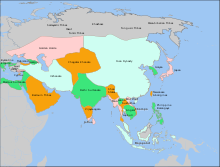利用者:Kaho88/sandbox

Turco-Mongol Tradition
[編集]Turco-Mongol or the Turko-Mongol tradition was a cultural or ethnocultural synthesis that arose during the 14th century, among the ruling elites of mongol Empire successor states such as the Chagatai Khanate and Golden Horde. These elites adopted Islam, while retaining Mongol political and legal institutions.
Historical Background
[編集]Prehistoric Times
[編集]In the prehistoric era, mankind with Shamanism faith first emigrated. With the innovations that occurred during the Neolithic Age, human beings living in the dry belt of Inland Asia could adapt to the environment at that time. The area has produced crops for centuries and towns and cities appeared in 3000 BC against the background of their surplus products. These gradually became hubs of trade and handicrafts, where a unique oasis culture developed. In 4000 BC, people noticed that living animals were better suited than in agriculture, and changed to nomads who lived in livestock as living.

Hsiung-Nu (the Huns) Empire
[編集]Showing the precedent of the shift from decentralized tribal micro-politics to empire to the large scale macro-politics by the first time established by the Huns. As a result, the models of relying of Turkic and Mongolia has been fixed.As a result of losing to China and beginning to move to the west, Turkicization of Western Eurasia began.
Gokturks Empire
[編集]
This empire realized "Pax-Turkika" for a relatively long term from the standard of inland Asia. In general it played the role of propagating not only goods but also thought through a long trade route from China to Constantinople, which is said to be Silk Road.Various successor states and Turkic tribes that appeared after the collapse of the empire began moving to the west after 840 AD. This west area ethnically changed from the core zone of Turkic to the core zone of Mongolia.
Mongol Empire states
[編集]Mongolia of the 13th century was originally located in the frontier of the Islamic region, and for the first time reintegrated residents of Steppe into one state since the Gokturks Empire. Mongolia created the "greatest land Empire in history" and permanently joined Eurasia as a system. The Mongol empire incorporating Steppe culture left a society in which the ethnic group is Turkic, religion as a Muslims occupy the majority afterwards.
Turkic People
[編集]Religion
[編集]Tengrism
[編集]Tengrism is an ancient religion, especially with people in Central Asia including Huns and Mongolians. Tengrism is based on faith in Tengri Goddess and the Earth goddess Erlik. However, there are no clerics and others, so there is nothing to propagate to others, so it is known for not having distinct doctrines. The Tengrism faithful emphasizes harmonizing with the surrounding environment and considers the ground resources to be sacred. In particular, water was more valiantly sometimes valuable in the Central Asian prairies where there were many faithfuls. The Tengrism faithful is still considered to be part of Asia, but unknown of the exact number.[1]
The early Mongol rulers, though followers of Tengri, were tolerant of other religions. One of the unique features of Tengriism is its non-dogmatism. It did not force its dogma on other religious though other religions succeeded in doing the same. The Mongol rulers believed that they were the sons of Tengri and they could rule as long as they were upright and followed the laws of Tengri. If they became wayward, Tengri would withdraw his grace and support, and the ruler would fall.[2]
Tengriism believes there is only one supreme God. His name is Tengri and he is unknowable. He is aware of everything and knows everything. So a lot of Mongols and Turks are often heard saying 'only Tengri knows.'[3]
Language
[編集]Proto-Turkic
[編集]Proto-Mongolic
[編集]Culture
[編集]Effects
[編集]Timur i'd Empire
[編集]Kazakh Khanate
[編集]Khanate of Kazan
[編集]Crimean Khanate
[編集]Mughal Empire
[編集]See also
[編集]References
[編集]Carter Vaughn Findley (author), Sasaki Shin (translator), Komatsu Hisao (supervised translator), 『テュルクの歴史 古代から近現代まで』,明石書店,<世界歴史叢書>,2017.
[https://www.discovermongolia.mn/blog-news-the-ancient-religion-of-tengriism/]
 |
ここはKaho88さんの利用者サンドボックスです。編集を試したり下書きを置いておいたりするための場所であり、百科事典の記事ではありません。ただし、公開の場ですので、許諾されていない文章の転載はご遠慮ください。
登録利用者は自分用の利用者サンドボックスを作成できます(サンドボックスを作成する、解説)。 その他のサンドボックス: 共用サンドボックス | モジュールサンドボックス 記事がある程度できあがったら、編集方針を確認して、新規ページを作成しましょう。 |
- ^ “The Ancient Religion of Tengriism”. Discover Mongolia Travel Guide - Travel to Mongolia 2018年6月9日閲覧。
- ^ “The Ancient Religion of Tengriism”. Discover Mongolia Travel Guide - Travel to Mongolia 2018年6月9日閲覧。
- ^ “The Ancient Religion of Tengriism”. Discover Mongolia Travel Guide - Travel to Mongolia 2018年6月9日閲覧。
